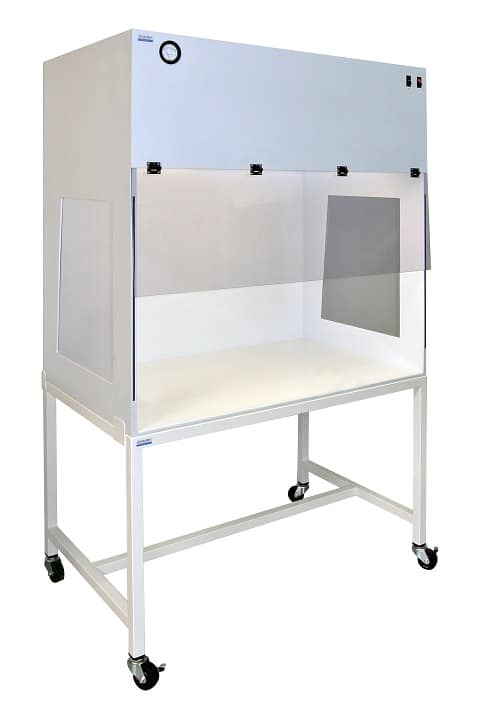Wondering how to keep your vertical laminar hood clean? Follow this comprehensive guide to gain complete insights regarding cleaning the vertical laminar hoods.
Laminar airflow hoods are a must in almost every lab that actively works on the field of chemistry, biology, and associated medical fields. These are enclosed physical spaces that create a sanitized and contamination-free environment in which you can easily accomplish your microbe related works without thinking about the contamination issues. It also keeps the workers safe from harmful pathogens and microbes as it circulates the air inside and purifies it. There are two major types of laminar airflow systems; Vertical and Horizontal. Both of these systems use a HEPA filter which has major roles in making the air clean and free from any microbial particles.
Now, there are 3 different classes of laminar airflow systems available in the market. Both the horizontal and vertical systems come in these 3 classes as well. before going to the cleaning and maintenance section let us focus first into these classes so that we can learn about the machine in a better way.
As mentioned before, 3 different classes of laminar airflow systems have been created to meet the specific demands and requirements of different backgrounds.
- The Class I Laminar Hoods are made for basic biosafety related works. It does not give you 100% protection from the contaminants and neither has it purified the air completely. You can use it in doing basic works where there is a lesser chance of contamination.
- The second class on the other hand are made to created sterile environments that meet the Bio-Safety levels 1, 2, and 3. These will protect you from different types of hazardous fumes, volatile compounds, and contaminants.
- The third and final class of laminar flow systems is designed to offer you the Bio-Safety Level 4 sterile and contaminant-free workspace. These are highly used in microbiological labs that work with highly infectious microbes and human pathogens.
Now, that we have acquired the basic knowledge regarding laminar airflow hoods. Let us focus on the cleaning part of laminar airflow systems. We will be focusing on cleaning the Vertical Laminar Flow Hoods as these are mostly used in different fields nowadays. We will discuss the complete cleaning method in 4 below-mentioned steps.
- Focus on preparing cleaning equipment
The First step for any cleaning operation is to prepare all the necessary components which will be necessary for the process. Get a 70 percent ethanol solution or any other disinfecting solution that is used in your lab or whichever cleaner is recommended by your laminar hood manufacturer.
Do not use soap as it will add an extra layer on the work surface which will become a bit problematic to work on. Next, take a sterile or autoclaved pack of gauze or cotton or any other sterile laboratory-grade wipes.
You need to wear a complete personal protective gear to clean the laminar hood as you do not know what kind of contaminant it hosts. Putting on gloves, eye, and face protection is very important to avoid unwanted exposure to contaminants or radioactive wastes. Always wear a lab coat before starting the cleaning process and never forget to wear shoes that completely cover your feet.
- Beginning the cleanup
Before starting the cleanup, do not forget to turn the laminar airflow on and then open the hood cover or sash. This will help the air to circulate from the very beginning. Allow this to happen for at least 5 minutes before starting the cleanup. Remove all the foreign objects first.
These include the components which are not part of the laminar hood such as, pipette tip boxes, pipettes, and pipette stands, lighter, and the burner as well. You can take an autoclaved or sterile bag and open it inside the laminar hood and put these things inside. The bag should be properly sealed and then taken outside the laminar hood to maintain its sterile nature.
- Wipe and clean the debris to get a new laminar hood
You need to clean up all the debris first and put them separately in an autoclavable bag. Next focus on the spills and stains. The airflow gates should be removed and you should mop the work surface thoroughly with the respective disinfectant.
Remember to spray the disinfectant or alcohol on a sterile wipe or gauze and notdirectly on the work surface as the strong airflow will dry the disinfectant out quickly. Do the same thing for the internal hood parts like the sash and the frontal and back portions of it. But finish each position at once and then move on to the next one.
- Final decontamination with UV lamp
After the cleaning part is completed, you need to decontaminate the airflow worksurface with the UV-lamp which comes with the system. Switch on the UV-lamp for 10-15 minutes after the disinfectant has completely dried and you have finished the cleaning of the complete system. Do not forget to close the sash and switch off the airflow before switching the UV on.
Excited to start the cleaning operation?
We hope that these tips were useful for your cleaning purpose and you have learned the basics of cleaning the vertical laminar flow hoods of your lab.
Please remain cautious throughout the complete process as you might have to tackle hazardous substances while cleaning. Keep a Bio Hazard bag handy all the time to put the potential hazardous materials. Stay safe and happy working!!
